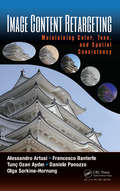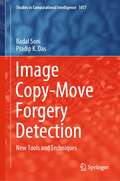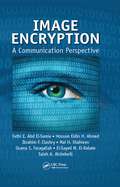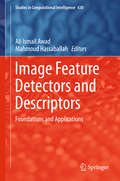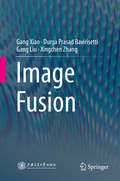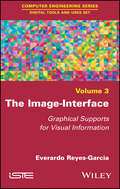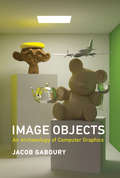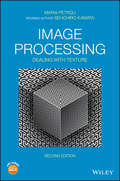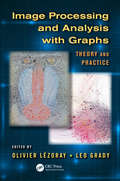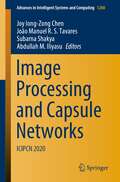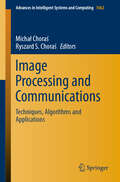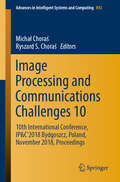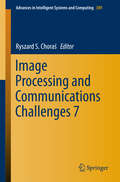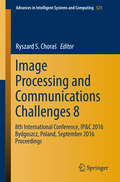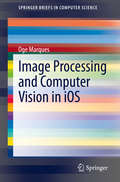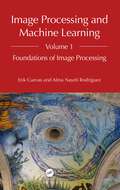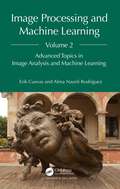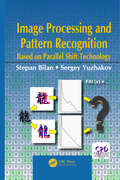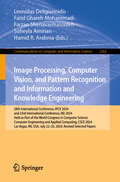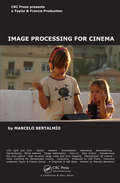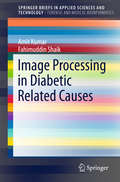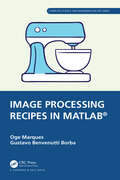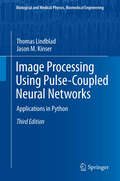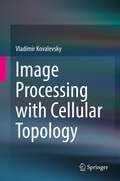- Table View
- List View
Image Content Retargeting: Maintaining Color, Tone, and Spatial Consistency
by Alessandro Artusi Francesco Banterle Tunç Ozan Aydın Daniele Panozzo Olga Sorkine-HornungIn recent years visual devices have proliferated, from the massive high-resolution, high-contrast screens to the tiny ones on mobile phones, with their limited dynamic range and color gamut. The wide variety of screens on which content may be viewed creates a challenge for developers. Adapting visual content for optimized viewing on all devices is called retargeting. This is the first book to provide a holistic view of the subject, thoroughly reviewing and analyzing the many techniques that have been developed for retargeting along dimensions such as color gamut, dynamic range, and spatial resolution.
Image Copy-Move Forgery Detection: New Tools and Techniques (Studies in Computational Intelligence #1017)
by Badal Soni Pradip K. DasThis book presents a detailed study of key points and block-based copy-move forgery detection techniques with a critical discussion about their pros and cons. It also highlights the directions for further development in image forgery detection. The book includes various publicly available standard image copy-move forgery datasets that are experimentally analyzed and presented with complete descriptions. Five different image copy-move forgery detection techniques are implemented to overcome the limitations of existing copy-move forgery detection techniques. The key focus of work is to reduce the computational time without adversely affecting the efficiency of these techniques. In addition, these techniques are also robust to geometric transformation attacks like rotation, scaling, or both.
Image Encryption: A Communication Perspective
by Osama S. Faragallah El-Sayed M. El-Rabaie Fathi E. Abd El-Samie Hossam Eldin Ahmed Ibrahim F. Elashry Mai H. Shahieen Saleh A. AlshebeiliInvestigating image encryption approaches, this book examines image encryption algorithms for the purpose of wireless communication of images in secure form. It considers two directions for image encryption: permutation-based encryption and diffusion-based encryption. Covering the range of image encryption principles and techniques, it presents hybrid encryption algorithms to enhance the characteristics of traditional algorithms. It explores number theory-based encryption algorithms, details the strength of different encryption algorithms, and describes their ability to work within the limitations of wireless communication systems.
Image Feature Detectors and Descriptors
by Ali Ismail Awad Mahmoud HassaballahThis bookprovides readers with a selection of high-quality chapters that cover boththeoretical concepts and practical applications of image feature detectors anddescriptors. It serves as reference for researchers and practitioners byfeaturing survey chapters and research contributions on image feature detectorsand descriptors. Additionally, it emphasizes several keywords in boththeoretical and practical aspects of image feature extraction. The keywordsinclude acceleration of feature detection and extraction, hardwareimplantations, image segmentation, evolutionary algorithm, ordinal measures, aswell as visual speech recognition.
Image Fusion
by Gang Xiao Durga Prasad Bavirisetti Gang Liu Xingchen ZhangThis book systematically discusses the basic concepts, theories, research and latest trends in image fusion. It focuses on three image fusion categories – pixel, feature and decision – presenting various applications, such as medical imaging, remote sensing, night vision, robotics and autonomous vehicles. Further, it introduces readers to a new category: edge-preserving-based image fusion, and provides an overview of image fusion based on machine learning and deep learning. As such, it is a valuable resource for graduate students and scientists in the field of digital image processing and information fusion.
The Image-Interface: Graphical Supports for Visual Information
by Everardo Reyes-GarciaDigital practices are shaped by graphical representations that appear on the computer screen, which is the principal surface for designing, visualizing, and interacting with digital information. Before any digital image or graphical interface is rendered on the screen there is a series of layers that affect its visual properties. To discover such processes it is necessary to investigate software applications, graphical user interfaces, programming languages and code, algorithms, data structures, and data types in their relationship with graphical outcomes and design possibilities. This book studies interfaces as images and images as interfaces. It offers a comprehensible framework to study graphical representations of visual information. It explores the relationship between visual information and its graphical supports, taking into account contributions from fields of visual computing. Graphical supports are considered as material but also as formal aspects underlying the representation of digital images on the digital screen.
Image Objects: An Archaeology of Computer Graphics
by Jacob GabouryHow computer graphics transformed the computer from a calculating machine into an interactive medium, as seen through the histories of five technical objects.Most of us think of computer graphics as a relatively recent invention, enabling the spectacular visual effects and lifelike simulations we see in current films, television shows, and digital games. In fact, computer graphics have been around as long as the modern computer itself, and played a fundamental role in the development of our contemporary culture of computing. In Image Objects, Jacob Gaboury offers a prehistory of computer graphics through an examination of five technical objects--an algorithm, an interface, an object standard, a programming paradigm, and a hardware platform--arguing that computer graphics transformed the computer from a calculating machine into an interactive medium. Gaboury explores early efforts to produce an algorithmic solution for the calculation of object visibility; considers the history of the computer screen and the random-access memory that first made interactive images possible; examines the standardization of graphical objects through the Utah teapot, the most famous graphical model in the history of the field; reviews the graphical origins of the object-oriented programming paradigm; and, finally, considers the development of the graphics processing unit as the catalyst that enabled an explosion in graphical computing at the end of the twentieth century. The development of computer graphics, Gaboury argues, signals a change not only in the way we make images but also in the way we mediate our world through the computer--and how we have come to reimagine that world as computational.
Image Processing: Dealing with Texture
by Maria M. Petrou Sei-ichiro KamataThe classic text that covers practical image processing methods and theory for image texture analysis, updated second edition The revised second edition of Image Processing: Dealing with Textures updates the classic work on texture analysis theory and methods without abandoning the foundational essentials of this landmark work. Like the first, the new edition offers an analysis of texture in digital images that are essential to a diverse range of applications such as: robotics, defense, medicine and the geo-sciences. Designed to easily locate information on specific problems, the text is structured around a series of helpful questions and answers. Updated to include the most recent developments in the field, many chapters have been completely revised including: Fractals and Multifractals, Image Statistics, Texture Repair, Local Phase Features, Dual Tree Complex Wavelet Transform, Ridgelets and Curvelets and Deep Texture Features. The book takes a two-level mathematical approach: light math is covered in the main level of the book, with harder math identified in separate boxes. This important text: Contains an update of the classic advanced text that reviews practical image processing methods and theory for image texture analysis Puts the focus exclusively on an in-depth exploration of texture Contains a companion website with exercises and algorithms Includes examples that are fully worked to enhance the learning experience Written for students and researchers of image processing, the second edition of Image Processing has been revised and updated to incorporate the foundational information on the topic and information on the latest advances.
Image Processing and Analysis with Graphs: Theory and Practice (Digital Imaging and Computer Vision #5)
by OLIVER LÉZORAY AND LEO GRADYCovering the theoretical aspects of image processing and analysis through the use of graphs in the representation and analysis of objects, Image Processing and Analysis with Graphs: Theory and Practice also demonstrates how these concepts are indispensible for the design of cutting-edge solutions for real-world applications. Explores new applications in computational photography, image and video processing, computer graphics, recognition, medical and biomedical imaging With the explosive growth in image production, in everything from digital photographs to medical scans, there has been a drastic increase in the number of applications based on digital images. This book explores how graphs—which are suitable to represent any discrete data by modeling neighborhood relationships—have emerged as the perfect unified tool to represent, process, and analyze images. It also explains why graphs are ideal for defining graph-theoretical algorithms that enable the processing of functions, making it possible to draw on the rich literature of combinatorial optimization to produce highly efficient solutions. Some key subjects covered in the book include: Definition of graph-theoretical algorithms that enable denoising and image enhancement Energy minimization and modeling of pixel-labeling problems with graph cuts and Markov Random Fields Image processing with graphs: targeted segmentation, partial differential equations, mathematical morphology, and wavelets Analysis of the similarity between objects with graph matching Adaptation and use of graph-theoretical algorithms for specific imaging applications in computational photography, computer vision, and medical and biomedical imaging Use of graphs has become very influential in computer science and has led to many applications in denoising, enhancement, restoration, and object extraction. Accounting for the wide variety of problems being solved with graphs in image processing and computer vision, this book is a contributed volume of chapters written by renowned experts who address specific techniques or applications. This state-of-the-art overview provides application examples that illustrate practical application of theoretical algorithms. Useful as a support for graduate courses in image processing and computer vision, it is also perfect as a reference for practicing engineers working on development and implementation of image processing and analysis algorithms.
Image Processing and Capsule Networks: ICIPCN 2020 (Advances in Intelligent Systems and Computing #1200)
by João Manuel R. S. Tavares Joy Iong-Zong Chen Subarna Shakya Abdullah M. IliyasuThis book emphasizes the emerging building block of image processing domain, which is known as capsule networks for performing deep image recognition and processing for next-generation imaging science. Recent years have witnessed the continuous development of technologies and methodologies related to image processing, analysis and 3D modeling which have been implemented in the field of computer and image vision. The significant development of these technologies has led to an efficient solution called capsule networks [CapsNet] to solve the intricate challenges in recognizing complex image poses, visual tasks, and object deformation. Moreover, the breakneck growth of computation complexities and computing efficiency has initiated the significant developments of the effective and sophisticated capsule network algorithms and artificial intelligence [AI] tools into existence. The main contribution of this book is to explain and summarize the significant state-of-the-art research advances in the areas of capsule network [CapsNet] algorithms and architectures with real-time implications in the areas of image detection, remote sensing, biomedical image analysis, computer communications, machine vision, Internet of things, and data analytics techniques.
Image Processing and Communications: Techniques, Algorithms and Applications (Advances in Intelligent Systems and Computing #1062)
by Michał Choraś Ryszard S. ChoraśThis book presents a selection of high-quality peer-reviewed research papers on various aspects of computer science and networks. It not only discusses emerging applications of currently available solutions, but also outlines potential future techniques and lines of research in pattern recognition, image processing and communications. Given its scope, the book will be of considerable interest to researchers, students and practitioners alike. All papers gathered here were presented at the Image Processing and Communications Conference, held in Bydgoszcz, Poland on September 11–13, 2019.
Image Processing and Communications Challenges 10: 10th International Conference, IP&C’2018 Bydgoszcz, Poland, November 2018, Proceedings (Advances in Intelligent Systems and Computing #892)
by Michał Choraś Ryszard S. ChoraśPresenting a collection of high-quality research papers on image processing and communications, this book not only discusses emerging applications of the currently available solutions, but also outlines potential future techniques and research directions in these areas. Gathering the proceedings of the 10th International Conference on Image Processing and Communications (IP&C 2018), held in Bydgoszcz, Poland in November 2018, it is divided into two parts. Part I focuses on image processing, offering a comprehensive survey of available methods and discussing current trends in computer vision. In turn, Part II presents novel results on networks, communications and a diverse range of applications, including cybersecurity and cloud computing.
Image Processing and Communications Challenges 7
by Ryszard S. ChoraśThis book contains papers accepted for IP&C 2015, the International Conference on Image Processing and Communications, held at UTP University of Science and Technology, Bydgoszcz, Poland, September 9-11, 2015. This conference was the eighth edition in the IP&C series of annual conferences. This book and the conference have the aim to bring together researchers and scientists in the broad fields of image processing and communications, addressing recent advances in theory, methodology and applications. The book will be of interest to a large group of researchers, engineers and practitioners in image processing and communications.
Image Processing and Communications Challenges 8
by Ryszard S. ChoraśThis book collects a series of research papers in the area of Image Processing and Communications which not only introduce a summary of current technology but also give an outlook of potential feature problems in this area. The key objective of the book is to provide a collection of comprehensive references on some recent theoretical development as well as novel applications in image processing and communications. The book is divided into two parts and presents the proceedings of the 8th International Image Processing and Communications Conference (IP&C 2016) held in Bydgoszcz, Poland September 7-9 2016. Part I deals with image processing. A comprehensive survey of different methods of image processing, computer vision is also presented. Part II deals with the telecommunications networks and computer networks. Applications in these areas are considered.
Image Processing and Computer Vision in iOS (SpringerBriefs in Computer Science)
by Oge MarquesThis book presents the fundamentals of mobile visual computing in iOS development and provides directions for developers and researchers interested in developing iOS applications with image processing and computer vision capabilities. Presenting a technical overview of some of the tools, languages, libraries, frameworks, and APIs currently available for developing iOS applications Image Processing and Computer Vision in iOS reveals the rich capabilities in image processing and computer vision. Its main goal is to provide a road map to what is currently available, and a path to successfully tackle this rather complex but highly rewarding task.
Image Processing and Intelligent Computing Systems
by Prateek Singhal Abhishek Verma Prabhat Kumar Srivastava Virender Ranga Ram KumarThere is presently a drastic growth in multimedia data. During the Covid-19 pandemic, we observed that images helped doctors immensely in the rapid detection of Covid-19 infection in patients. There are many critical applications in which images play a vital role. These applications use raw image data to extract some useful information about the world around us. The quick extraction of valuable information from raw images is one challenge that academicians and professionals face in the present day. This is where image processing comes into action. Image processing’s primary purpose is to get an enhanced image or extract some useful information from raw image data. Therefore, there is a major need for some technique or system that addresses this challenge. Intelligent Systems have emerged as a solution to address quick image information extraction. In simple words, an Intelligent System can be defined as a mathematical model that adapts itself to deal with a problem’s dynamicity. These systems learn how to act so an image can reach an objective. An Intelligent System helps accomplish various image-processing functions like enhancement, segmentation, reconstruction, object detection, and morphing. The advent of Intelligent Systems in the image-processing field has leveraged many critical applications for humankind. These critical applications include factory automation, biomedical imaging analysis, decision econometrics, as well as related challenges.
Image Processing and Machine Learning, Volume 1: Foundations of Image Processing
by Erik Cuevas Alma Nayeli RodríguezImage processing and machine learning are used in conjunction to analyze and understand images. Where image processing is used to pre-process images using techniques such as filtering, segmentation, and feature extraction, machine learning algorithms are used to interpret the processed data through classification, clustering, and object detection. This book serves as a textbook for students and instructors of image processing, covering the theoretical foundations and practical applications of some of the most prevalent image processing methods and approaches. Divided into two volumes, this first installment explores the fundamental concepts and techniques in image processing, starting with pixel operations and their properties and exploring spatial filtering, edge detection, image segmentation, corner detection, and geometric transformations. It provides a solid foundation for readers interested in understanding the core principles and practical applications of image processing, establishing the essential groundwork necessary for further explorations covered in Volume 2. Written with instructors and students of image processing in mind, this book’s intuitive organization also contains appeal for app developers and engineers.
Image Processing and Machine Learning, Volume 2: Advanced Topics in Image Analysis and Machine Learning
by Erik Cuevas Alma Nayeli RodríguezImage processing and machine learning are used in conjunction to analyze and understand images. Where image processing is used to pre-process images using techniques such as filtering, segmentation, and feature extraction, machine learning algorithms are used to interpret the processed data through classification, clustering, and object detection. This book serves as a textbook for students and instructors of image processing, covering the theoretical foundations and practical applications of some of the most prevalent image processing methods and approaches. Divided into two volumes, this second installment explores the more advanced concepts and techniques in image processing, including morphological filters, color image processing, image matching, feature-based segmentation utilizing the mean shift algorithm, and the application of singular value decomposition for image compression. This second volume also incorporates several important machine learning techniques applied to image processing, building on the foundational knowledge introduced in Volume 1. Written with instructors and students of image processing in mind, this book’s intuitive organization also contains appeal for app developers and engineers.
Image Processing and Pattern Recognition Based on Parallel Shift Technology
by Stepan Bilan Sergey YuzhakovThis book describes the methods and algorithms for image pre-processing and recognition. These methods are based on a parallel shift technology of the imaging copy, as well as simple mathematical operations to allow the generation of a minimum set of features to describe and recognize the image. This book also describes the theoretical foundations of parallel shift technology and pattern recognition. Based on these methods and theories, this book is intended to help researchers with artificial intelligence systems design, robotics, and developing software and hardware applications.
Image Processing, Computer Vision, and Pattern Recognition and Information and Knowledge Engineering: 28th International Conference, IPCV 2024, and 23rd International Conference, IKE 2024, Held as Part of the World Congress in Computer Science, Computer Engineering and Applied Computing, CSCE 2024, Las Vegas, NV, USA, July 22–25, 2024, Revised Selected Papers (Communications in Computer and Information Science #2262)
by Hamid R. Arabnia Leonidas Deligiannidis Soheyla Amirian Farzan Shenavarmasouleh Farid Ghareh MohammadiThis book constitutes the proceedings of the 28th International Conference on Image Processing, Computer Vision, and Pattern Recognition, IPCV 2024, and the 23rd International Conference on Information and Knowledge Engineering, IKE 2024, held as part of the 2024 World Congress in Computer Science, Computer Engineering and Applied Computing, in Las Vegas, USA, during July 22 to July 25, 2024. The 19 IPCV 2024 papers included in these proceedings were carefully reviewed and selected from 98 submissions. IKE 2024 received 40 submissions and accepted 10 papers for inclusion in the proceedings. The papers have been organized in topical sections as follows: Image processing, computer vision and pattern recognition; image processing, computer vision and pattern recognition - detection methods; and information and knowledge engineering.
Image Processing for Cinema (Chapman & Hall/CRC Mathematical and Computational Imaging Sciences Series)
by Marcelo BertalmioImage Processing for Cinema presents a detailed overview of image processing techniques that are used in practice in digital cinema. The book shows how image processing has become ubiquitous in movie-making, from shooting to exhibition. It covers all the ways in which image processing algorithms are used to enhance, restore, adapt, and convert movi
Image Processing in Diabetic Related Causes
by Amit Kumar Fahimuddin ShaikThis book is a collection of all the experimental results and analysis carried out on medical images of diabetic related causes. The experimental investigations have been carried out on images starting from very basic image processing techniques such as image enhancement to sophisticated image segmentation methods. This book is intended to create an awareness on diabetes and its related causes and image processing methods used to detect and forecast in a very simple way. This book is useful to researchers, Engineers, Medical Doctors and Bioinformatics researchers.
Image Processing Recipes in MATLAB® (Chapman & Hall/CRC Computer Science and Engineering Recipes Series)
by Oge Marques Gustavo Benvenutti BorbaLeveraging the latest developments in MATLAB and its image processing toolbox, this 'cookbook' is a collection of 30 practical recipes for image processing, ranging from foundational techniques to recently published algorithms. Presented in a clear and meaningful sequence, these recipes are prepared with the reader in mind, allowing one to focus on particular topics or read as a whole from cover to cover.Key Features: A practical, user-friendly guide that equips researchers and practitioners with the tools to implement efficient image processing workflows in MATLAB. Each recipe is presented through clear, step-by-step instructions and rich visual examples. Each recipe contains its own source code, explanations, and figures, making the book an excellent standalone resource for quick reference. Strategically structured to aid sequential learning, yet with self-contained chapters for those seeking solutions to specific image processing challenges. The book serves as a concise and readable practical reference to deploy image processing pipelines in MATLAB quickly and efficiently. With its accessible and practical approach, the book is a valuable guide for those who navigate this evolving area, including researchers, students, developers, and practitioners in the fields of image processing, computer vision, and image analysis.
Image Processing using Pulse-Coupled Neural Networks: Applications in Python
by Thomas Lindblad Jason M. KinserImage processing algorithms based on the mammalian visual cortex are powerful tools for extraction information and manipulating images. This book reviews the neural theory and translates them into digital models. Applications are given in areas of image recognition, foveation, image fusion and information extraction. The third edition reflects renewed international interest in pulse image processing with updated sections presenting several newly developed applications. This edition also introduces a suite of Python scripts that assist readers in replicating results presented in the text and to further develop their own applications.
Image Processing with Cellular Topology
by Vladimir KovalevskyThis book explains why the finite topological space known as abstract cell complex is important for successful image processing and presents image processing methods based on abstract cell complex, especially for tracing and encoding of boundaries of homogeneous regions. Many examples are provided in the book, some teach you how to trace and encode boundaries in binary, indexed and colour images. Other examples explain how to encode a boundary as a sequence of straight-line segments which is important for shape recognition. A new method of edge detection in two- and three-dimensional images is suggested. Also, a discussion problem is included in the book: A derivative is defined as the limit of the relation of the increment of the function to the increment of the argument as the latter tends to zero. Is it not better to estimate derivatives as the relation of the increment of the function to the optimal increment of the argument instead of taking exceedingly small increment which leads to errors? This book addresses all above questions and provide the answers.
